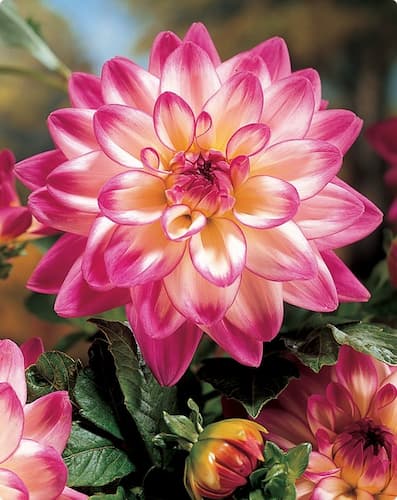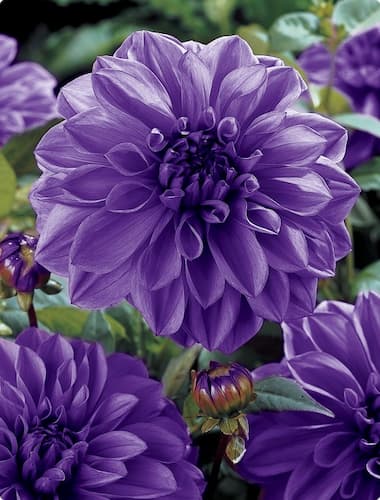How to Grow Dahlia Flowers

Growing Perennial Dahlia Flower in Your Home Garden
Originally from Mexico, Perennial Dahlia flowers are a big family of big-bloomed flowering plants. It’s a very big family with hundreds of varieties. Why, there’s a Dahlia for everyone! And, flower heads range from small pompons to several inches in diameter. So, what are you waiting for!? Use this guide to learn how to grow dahlias. Then, get growing!
These attractive plants produce loads of brilliant blooms. Flowers include single bloom, double bloom, and more. And, if color is what you are looking for, growing Dahlias are your answer.
Dahlia flowers can produce very, very big blooms. Some varieties are known as “Dinner Plate Dahlias”. Can you guess why!?
Now for the best news… Dahlias are easy to grow. So make sure to include some in your flower beds. After they bloom and adorn your yard, they will keep your vases. Blooms from late summer to fall.
Try Dahlias in pots or containers on your patio or deck.
Dahlias look good in the garden, and as cut flowers.
Dahlia Plant Specifications
Flower Colors: Includes rainbows of orange, salmon, bronze, apricot, yellow, crimson, scarlet, and lavender. Sorry, there are no blues.
Flowers Bloom: From Summer through to the first Fall Frost.
Plant Height: 1 to 5 feet depending upon variety.
Light Requirements: Grow plants in full sun.
Ideal Soil pH: 6.0 – 7.5.
Hardiness Zone: 8 – 11.
Toxicity: Non-toxic.
Deer Resistant?: Yes
Invasive?: No.
Native To: All varieties are native to Mexico.
Plant Type: Perennial. However, in colder regions, they are grown as annuals.
Botanical Name: Dahlia
Are Dahlia Plants Edible?
YES!! Although, many people believe they are toxic. There is considerable disagreement and confusion about their edibility. Dahlia are a good source of fiber, and many vitamins and minerals.
Use the colorful petals in salads, soups, and as a garnish. the tubers look similar to sweet potatoes or yams. Boil or roast them first. This neutralizes the toxins in the tubers. It is an important step prior to eating them. They make a tasty side dish. Or, add them to soups, and stews. Also, you can dry the tubers and grind them into flour.
Medicinal Applications for Dahlia
There are numerous medicinal applications for Dahlia. Here are some of them:
- Crush and mash the petals to treat insect bites. Also, use it to treat skin sores.
- Got tired feet? Use the petals in a foot bath.
- The skin of the tubers contains antibiotic properties.
- Ancient Aztecs used it as a treatment for epilepsy.
- It helps to lower cholesterol and triglycerides.
- Use it to help control diabetes.
Light Requirements
Grow Dahlia plants in full sun. They require at least 6 – 8 hours of direct sunlight for profuse and healthy blooms.
Afternoon shade is beneficial in hotter regions of the country.
Perennial Dahlia Plant Propagation
Dahlia can be grown from seed. Start Dahlia seeds indoors six to eight weeks before the last frost in your area. We recommend planting them in separate pots, allowing ample room for root growth. This will make transplanting easier. Set the new plants out into their summer home after the last frost date in your area.
Established Dahlia plants are frequently propagated by the separation of their tubular roots. This can be very useful as you are assured of the color of the new plants. Dig a hole 6-10 inches deep. Mix in plenty of manure and compost. Bury the roots with the crowns 3″ below the surface. Propagation by cuttings is also possible, but somewhat uncommon. More on growing plants from cuttings.
Days to Seed Germination: 7 – 14 days.

How to Grow Dahlia Flower Plants
Perennial Dahlia plants are very easy to grow. They prefer full sun.
The plants are big feeders. Make sure the soil is rich and fertile. Soft loam soil is best. Add plenty of compost and apply mulch to the planting site.
Low nitrogen fertilizer should be applied regularly all season. Keep the soil moist but drained, at all times.
Space smaller varieties 16″ apart. The largest varieties should be spaced 2 feet apart to allow ample room for growth. After the plants have grown about a foot, pinch back the stems to promote a bushier growth.
Dahlia plants grow quickly and will bloom in mid-late summer. Stem tips will develop multiple buds, usually three. To grow bigger blooms disbud the two side buds, leaving the middle, terminal bud.
The flowers are proudly displayed on strong stems. However, with insufficient sunlight, the stems can be a little lanky. Stake the stems only if needed.
For use as cut flowers, sear the cut end with a match or candle.
How to Grow Dahlia - Pruning Plants
Dahlia plants benefit from careful trimming and pruning.
After the plants have grown a foot or so tall (more for taller varieties), pinch off the growing tips. This plant will become bushier, and more attractive. And, you will get more blooms.
Remove any dead, sickly, or damaged leaves and stems.
Deadheading spent blooms promotes new flower buds.
At the end of the growing season, cut dead plants to the ground. For cold weather regions, see “Overwintering Dahlia Plants” below.
Insects and Plant Disease
Lots of insects love Dahlias. Slugs and sucking insects, most notably red spiders and mites, can be a real problem. Make sure to put down slug pellets or other slug protection on a routine basis. Use insecticides or insecticidal soaps.
Disease problems can also occur. If you spot it, treat it early with a fungicide.
Also see: Plant Problems – Identify the causes and find the cures.
Overwintering Dahlia Plants
Dahlia plants will succumb to a hard frost. Dig up the tubers, and place them in a bed of dry sand. Store them in your cellar over the winter and replant them in the spring. Do not store them where the bulbs can freeze.
You can mark the tubers with the flower color if desired.
Related Articles
People who read this article on growing dahlias will also like:
How to Grow Dahlia Plants – by Garden Hobbies
Please support our site. Shop for:
- rmmatthews100@hotmail.com
- 585-721-6528
- Rochester, NY
©1999-2024 GardenersNet.Com, All Rights Reserved

